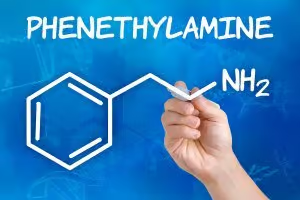Table of Contents
Key Takeaways
- Phenylethylamine (PEA) is a trace amino acid with stimulant and mood-enhancing effects, synthesized from L-Phenylalanine and found in certain foods and chocolate.
- PEA activates TAAR1 and TAAR2 receptors, leading to increased serotonin and dopamine release, potentially helping with anxiety, depression, and ADHD.
- Aging can lead to decreased PEA levels, which may be linked to ADHD, addiction, and neurodegenerative diseases.
- PEA shows promise as an antidepressant and a potential alternative to SSRIs, with ongoing studies for ADHD treatment.
- PEA has a short half-life, which can be extended by using it with a MAO-B inhibitor, and potential side effects include the “cheese effect” and other amphetamine-class side effects.
Phenylethylamine (PEA, 2-phenylethylamine, beta phenylethylamine / β-phenylethylamine, phenethylamine) is a trace amino acid. Your brain naturally converts L-Phenylalanine into Phenylethylamine (PEA).
PEA is not at the top of most nootropic stack choices because its effects are so short-lived. But some neurohackers love PEA for its stimulant and mood enhancing qualities.
The most famous promoter of phenylethylamine was Dr. Alexander Shulgin and his wife Anna. Dr. Shulgin published ‘PiHKAL: A Chemical Love Story’ in 1991. PiHKAL is short for “Phenethylamines I Have Known and Loved”.
Phenylethylamines are a group of phenethylamine derivatives which contain PEA as a backbone. These derivative compounds are formed by replacing one or more hydrogen atoms in the core structure.
This class of PEA compounds include amphetamines, empathogens, stimulants, psychedelics, appetite suppressants, bronchodilators, nasal decongestants, and antidepressants.
One of the more famous PEA derivatives is Methylenedioxymethamphetamine (MDMA or Ecstasy).
Dr. Shulgin developed, tested, and published the formulas for 179 different compounds largely based around the structure of PEA in his book PiHKAL.
In this review we investigate how phenylethylamine (PEA) works in the human brain.
Phenylethylamine helps:
- Anxiety & Depression. PEA activates TAAR1 and TAAR2 receptors which in turn prevents the uptake and boosts the release of the ‘feel-good’ neurotransmitters serotonin and dopamine.
- Neuroprotector. Monoamine oxidase inhibits the catecholamines like dopamine and norepinephrine. Decreases in dopamine levels are implicated in diseases like Parkinson’s. PEA helps boost dopamine and norepinephrine levels. Reducing the symptoms of neurodegenerative diseases.
- Attention Deficit Disorder (ADHD). PEA prevents the reuptake of dopamine and norepinephrine and inhibits their transport. Like the mechanism of action provided by ADHD stimulant meds. Some have found supplementing with PEA as a nootropic has decreased the symptoms of ADHD.
Overview
Phenylethylamine (PEA, 2-phenylethylamine, β-phenylethylamine, phenethylamine) is a trace amine naturally synthesized from L-Phenylalanine in your brain that links to your brain’s trace amine-associated receptor.

Aromatic amino-acid decarboxylase converts phenylalanine to phenylethylamine. This is the same enzyme that converts phenylalanine into dopamine. And it converts it at a rate comparable to the synthesis of dopamine.
But PEA is not retained in neuronal vesicles like dopamine is stored. Instead, monoamine oxidase-B (MAO-B) quickly degrades PEA.[i]
Despite its short half-life, PEA as a nootropic seems to be effective for increasing catecholamine activity by boosting dopamine and norepinephrine.[ii]
PEA can be found naturally in many cacao, algae, fungi, and bacteria as well as clover, beans, peas, and some food products such as Natto and eggs.
PEA is also found in chocolate where it is produced during cacao’s fermentation and roasting process.[iii]
PEA binds to C-protein-coupled receptors TAAR1 and TAAR2, receptors reserved specifically for trace amine use.[iv] These receptors are not used by other major neurotransmitters like dopamine or norepinephrine.
The half-life of PEA taken as a nootropic supplement is only 5 – 10 minutes.[v] Because it’s quickly degraded by monoamine oxidase-B (MAO-B).
Many neurohackers prolong the effects of PEA by using it with a monoamine oxidase-B inhibitor (MAOI) like selegiline (L-Deprenyl), hordenine, or Oat Straw.
How does Phenylethylamine work in the brain?
Phenylethylamine boosts brain health and function in several ways. But two in particular stand out.
- Phenylethylamine decreases depression. PEA naturally boosts the ‘feel-good’ neurotransmitters in your brain called serotonin and dopamine. Studies have shown that depressed patients when tested have lower levels of PEA.[vi]
In fact, some suggest that a PEA deficit may be the cause of depression in the first place. One study had 14 patients with major depression take up to 60 mg per day of Phenylethylamine (PEA) along with 10 mg of selegiline (L-Deprenyl) for up to 50 weeks.
Researchers found that “PEA produces sustained relief of depression in a significant number of patients, including some unresponsive to the standard treatments. PEA improves mood as rapidly as amphetamine but does not produce tolerance.”[vii]
- Phenylethylamine is a mesencephalic enhancer. PEA is considered a mesencephalic enhancer which is defined as “enhancer-sensitive neurons in the brain capable of working in a split-second on a high activity level due to endogenous enhancer substances”.[viii]
This means that PEA stimulates the release of dopamine, norepinephrine, and serotonin in the brain. But unlike stimulant drugs like amphetamine, which release a flood of these neurotransmitters in an uncontrolled manner.
PEA instead only increase the amount of neurotransmitters that get released when a neuron is stimulated by receiving an impulse from a neighboring neuron.
In other words, the pattern of the neurotransmitter release in not changed. But when the neuron would normally release a neurotransmitter, a larger than normal amount is released.[ix]
The result is nearly instantaneous improvements in cognitive performance, attention, awareness, pleasure, libido, and a sense of well-being.
Phenylethylamine is an endogenous (natural or ‘built-in’) amphetamine. This mechanism of action is how prescription ADHD stimulants like Adderall work. And the basis for many Schedule 1 drugs like MDMA[x], LSD, mescaline, and (crystal) methylamphetamine.[xi]
How things go bad
Phenylethylamine (PEA) is naturally metabolized by monoamine oxidase-B (MAO-B). But as we get older, MAO-B levels rise and suppress healthy levels of PEA.
Low PEA levels have been linked to several neurological diseases. And may result in:
↓ Increased chance of ADHD
↓ Increased chance of addiction
↓ Energy levels decline
↓ Working memory and mood decline
↓ Contributing to Parkinson’s Disease
On the other hand, excess levels of PEA has been linked to migraines and paranoid schizophrenia.
Phenylethylamine central nervous system benefits
Phenylethylamine (PEA) quickly crosses the blood-brain barrier once you take it. And you feel its effects right away.
 Activation of TAAR1 receptors inhibit the uptake and induces the release of dopamine, norepinephrine, and serotonin. It’s like turning up the volume of neuron activity.
Activation of TAAR1 receptors inhibit the uptake and induces the release of dopamine, norepinephrine, and serotonin. It’s like turning up the volume of neuron activity.
A higher concentration of all of these neurotransmitters increase feelings of pleasure, boosts motivation, improves memory and cognition, and reinforces impulse control.
PEA naturally maintains and regulates neuronal activity. Preventing over- or under-stimulation. When working as designed, PEA and other trace amines prevent metabolic dysfunction and neurological disorders.
As a neurotransmitter, PEA acts like, and looks similar to amphetamines. And produces effects normally associated with taking a stimulant (like the drug amphetamine Adderall). But unlike amphetamines, and because PEA is endogenous to the brain, side effects and tolerance are avoided.
PEA works in an area of the brain associated with emotions. Resulting in feelings of pleasure, more drive and impulse control, heightened creativity, and better sensory perception.
PEA improves libido, social behavior, a sense of wellbeing, and better overall performance.
PEA is currently being studied and used for the treatment of ADHD, depression, bipolar disorder, cognitive dysfunction like brain fog and poor concentration. And PEA looks promising for treating addiction and eating disorders.
How does Phenylethylamine feel?
PEA is rapidly broken down by monoamine oxidase-B (MAO) so unless you stack PEA with a brain chemical like a MAO-B inhibitor, don’t expect its effects to last. Most experience a peak within 15 minutes and sustained energy for 30 min. to an hour.
If you’re ADHD or ADD, you should see an improvement in mood, attention span, focus and mental clarity. Not quite the same effect you’d get from something like Adderall but with a side benefit of more sociability.
Neurohackers report taking a monoamine oxidase inhibitor (MAOI) supplement 15 minutes before a PEA dose and the effects should last about 2 hours. And there’s no crash like you’d normally experience with a stimulant. Just a general feeling of well-being once it wears off.
Some have reported PEA helped kick the habit of Phenibut or caffeine without going through withdrawal.
As a pre-workout supplement, PEA provides a more intense and focused workout.
Older neurohackers seem to feel even more benefit when using PEA. Likely because monoamine oxidase levels over-power dopamine the older you get. And using PEA, especially with a MAOI helps restore dopamine, the brain chemical called serotonin, and other neurotransmitters that are typically depressed with age.
PEA is a great nootropic for study because you should feel less anxiety, fewer panic attacks and less stress. And more motivation, a better mood, easier to maintain focus, and more energy.
Some report food cravings subside and it’s easier to lose weight.
Phenylethylamine Clinical Research
Phenylethylamine as an Antidepressant
Depression is the 2nd leading cause of disability among ages 15 – 44. By 2030, the World Health Organization predicts depression will be the leading cause of disability worldwide.[xii]
Selective serotonin reuptake inhibitors (SSRI) are the most popular antidepressants prescribed worldwide. SSRIs work by blocking the serotonin transporter and inhibiting the reuptake of the neurotransmitter in your brain called serotonin. Resulting in an increase of serotonin in synapses.
But the problem is SSRIs are slow to act. And come with a host of side effects. The sustained antidepressant effect of Phenylethylamine (PEA) may be an alternative to SSRIs.
A study done in 2008 showed that PEA alters serotonin transporters by interacting with TAAR receptors. Increasing serotonin levels by preventing their reuptake just like prescription SSRIs.
The study suggested that PEA may be a safer treatment for depression than SSRIs.[xiii]
Phenylethylamine for ADHD
The diagnosis of attention deficit hyperactivity disorder (ADHD) has traditionally been done by analysis of symptoms. But measuring PEA levels instead has recently been described as a possible biomarker for diagnosing ADHD.[xiv]
This discovery of a relationship between PEA levels and ADHD has excited researchers. Because it will hopefully improve levels of confidence during ADHD diagnosis. And reduce misdiagnosis and over-medication.
One study of ADHD children medicated with methylphenidate (Ritalin) had significantly higher PEA levels when using methylphenidate.[xv]
PEA binds to the TAAR1 receptor which alters monoamine transporter function. And leads to the inhibition of the reuptake of dopamine, serotonin, and norepinephrine. Which then increases the concentration of these neurotransmitters in neuron synapses.[xvi]
This increase in synaptic concentrations of dopamine can be accomplished by directly blocking the dopamine transporter. Which is how drugs like methylphenidate work to boost dopamine.
So if you are ADHD and crave chocolate, it’s likely because cocao supplies PEA.
Some naturopaths are beginning to prescribe PEA instead of stimulants like amphetamines or methylphenidate to treat ADHD.
Phenylethylamine Dosage
 Phenylethylamine (PEA) suggested dosage for cognitive benefit is 500 mg up to 3-times per day.
Phenylethylamine (PEA) suggested dosage for cognitive benefit is 500 mg up to 3-times per day.
PEA has a half-life of 5 – 10 minutes.[xvii] But the effects of PEA can be extended by using it with a MAO-B inhibitor.
If you do use a potent MAOI like selegiline (l-deprenyl) make sure you keep the dose low (i.e. 2.5 mg) or you’re in danger of inhibiting MAO-A as well. More on the “cheese effect” next.
Dosing more than recommended is NOT a good idea because you’ll likely feel jittery, irritable, get a headache, feel nausea, and very possibly force your heart rate to dangerous levels.
Phenylethylamine Side Effects
“Cheese effect”: Phenylethylamine (PEA) is metabolized by the enzyme MAO-B. And when monoamine oxidase (MAO) is inhibited by eating cheese, or any other prescription or natural MAO inhibitor (MAOI), the combination can result in a potentially dangerous increase in blood pressure.[xviii]
Studies show that selective MAO-B inhibition does NOT produce this cheese effect.[xix]
Examples of MAO-B selective inhibitors include low-dose selegiline (L-deprenyl), hordenine, Polygala Tenuifolia, Oat Straw, Glycyrrhiza uralensis (Chinese licorice root extract), Phellondendron amurense (Amur cork tree bark), Ferula assafoetida extract (resin), and Psoralea corylifolia (Bu Gu Zhi).[xx]
Do not use Phenylethylamine (PEA) if you are using a prescription MAOI like Marplan, Nardil, Azilect or Parnate, or have used one in the last 14 days.
Do not use PEA if you have phenylketonuria (PKU).
Too much PEA can cause irritability, nausea, amplified heart rate, jitteriness, and could be extremely dangerous.
Remember, Phenylethylamine (PEA) is a (natural) endogenous amphetamine. And used irresponsibly could produce the same dangerous side effects as anything else in the amphetamine-class of compounds.
Where to buy Phenylethylamine
Phenylethylamine (PEA) is available in capsules, tablets, and as a bulk powder.
DO NOT make the mistake of buying Phenylalanine instead of Phenylethylamine (PEA). Because it’s NOT the same thing. And is easily overlooked when searching for this nootropic.
You can buy Phenylethylamine in powder form from Bulk Supplements.
If you buy PEA in powder-form, you should invest in a capsule machine and make capsules. Because PEA is a particularly nasty tasting nootropic supplement.
Nootropics Expert Recommendation
 Phenylethylamine 500 mg up to 3-times per day
Phenylethylamine 500 mg up to 3-times per day
I recommend using Phenylethylamine (PEA) as a nootropic supplement.
Your body does synthesize some Phenylethylamine from phenylalanine which comes from foods like beans, cacao, peas, Natto and eggs.
But most of us don’t get enough Phenylethylamine from our diet. So supplementation could help. Phenylethylamine is highly bioavailable, and quickly crosses the blood-brain barrier. So you should feel its effects soon after you take it.
Phenylethylamine is helpful for most neurohackers to combat anxiety, stress, and sleep deprivation. It’ll boost dopamine, norepinephrine, and serotonin levels.
It’s particularly helpful if you take Phenylethylamine prior to a stressful situation, workout, or physically demanding job. And it’s a great nootropic for studying.
Phenylethylamine could be helpful to those dealing with ADHD/ADD. It’s a possible substitute to stimulant meds like Ritalin or Adderall for some people.
PEA will provide the dopamine your brain needs. And doesn’t produce the stimulant crash when it wears off.
PEA works well when stacked with L-Tyrosine (for dopamine), and CDP-Choline and ALCAR (for acetylcholine).
PEA is quickly degraded by monoamine oxidase-B. So to prologue its effects, stack it with a low-dose MAOI-B.
You can buy Phenylethylamine in powder form from Bulk Supplements.









Join The Discussion - 188 comments
Shahzad Mohiuddin
June 9, 2024
Hi David,
I have a question regarding this substance. I suffer from OCD and GAD as you know and I was thinking about getting professional help (CBT and therapy) because I have had a couple of consultations with you regarding all the nootropics I was taking. But I had a caffeine issue, and caffeine is an anxiogenic. It wasnt working well in my system.
But then, theres this new OTC supplement that came out on the market called Adderex XR.
It includes a proprietary blend of phenylthylamines, as well as theobromine, methyltheobromine, 1-3 dihexylamine, synephrine, and methylsynephrine. Based on this page, it states that phenylthylamine is an anti-anxiety substance. But when I looked it up everywhere on the web, I couldnt find anywhere it saying that it’s anti-anxiety. I understand that it could possibly reduce anxiety because it releases serotonin and makes you feel good. But since its similar to an amphetamine and is classified as a stimulant, wouldnt it be considered an anxiogen? I looked up everywhere on line. And it says that its an anxiogen, not anxioLYTIC. I have been using this as a substitute for SSRI, and SNRI to treat my GAD and OCD.
I also take valerian root and lemon balm along with it to take off any anxiety associated with it. And I drink one cup of tea in the morning and one cup of tea in the afternoon along with the adderex XR. So far, it works pretty well for me. What are your thoughts?
Shahzad
David Tomen
June 10, 2024
Shahzad, this is my research on Phenylethylamine (https://nootropicsexpert.com/phenylethylamine/). PEA looks and acts like an amphetamine which makes most who try it “feel” good. That is the nature of amphetamines. It is certainly not marketed as a anti-anxiety supplement. But it could work they way from some people depending on how your are wired, and the chemical makeup of your brain.
Shahzad Mohiuddin
June 15, 2024
Hi David. Thanks for the input. I just had a question about the ingredients. Heres the link to the supplement: Adderex-xr
Thes upplement is mainly a proprietary blend of phenylthylamines. Which I do enjoy the feeling of because its similar to adderall. It gives mes the energy and focus I need, but I only like it for the purpose of regulating my mood and doing workouts. I dont really like it as much for cognitive tasks like studying for exams, or socializing. Therefore, I only take it once a day in the morning, and it lasts 4 hours in my system.
I had bad issues with caffeine addiction. I used to take preworkouts that contained up to 400 mg of caffeine. But the half life is 3 hours and it would last the whole day (about 9 hours) and it wasnt good for my GAD and OCD. So my first question is, whats the half life of PEA? Are the effects still felt even after the 4 hour half life? My SECOND question is that the adderex xr contains 1-5 dimethylhexylamine, theobromine, and methyltheobromine. Can these stimulants make anxiety worse?
Thanks for your help,
Shahzad
David Tomen
June 17, 2024
PEA has a half-life of 5 – 10 minutes. you can extend its benefits by using a natural MAOI like I described above in this article.
Those ingredients may make your anxiety worse because they go on to produce dopamine and then norepinephrine. So it depends on if you are deficient in dopamine or have too much dopamine – you can often predict what your reaction will be to using the supplement depending on if you are dopamine deficient or high in dopamine.
Shahzad Mohiuddin
June 18, 2024
thanks so much for your input. If this is the case, then I guess perhaps the best treatment for my GAD/OCD would be SSRI or SNRI. I have major inattentiveness issues, as well as caffeine addiction which may have exacerbated my anxiety and OCD.
Also, here are a list of supplements that I take:
[author edit]
In the morning when I wake up:
Adderex X1
The reason why I’m telling you this is because last time I took luvox (SSRI for OCD) and it was interacting with a lot of the stuff that I was taking. Especially caffeine. And I dont want to quit the adderex (at least for now) because it relieves me of anxiety/ocd but it has weird side effects and doesnt feel quite natural. It just makes me feel good. Do you know what SSRI or SNRI would be good for me? And so it wouldnt interact with any of the supplements that I take.
Thank you so much for your feedback!
David Tomen
June 18, 2024
Shahzad, I do NOT do nootropic stack reviews in the comments section of this website or my YouTube channel. But I am available for a consultation if you need further help.
However, I am not a doctor and cannot give you advice on drugs.
Shahzad mohiuddin
June 20, 2024
Hey David,
Thanks for the input. I do a lot of cardio which I know releases dopamine. I run or swim until absolute failure (thinking that the harder you go, the more dopamine gets released, and hence, the happier the brain). Is this true or false? Also would taking caffeine (even just 1 cup of tea) before cardio be bad for me? I just found out that having too much dopamine in my brain (from too much stimulants and extreme cardio) I’d not healthy for the brain because it causes anxiety. And so all this while I was thinking the harder I go the better I feel. Whats your input on this?
Shahzad
David Tomen
June 20, 2024
Shahzad, the dopamine released during exercise will only be the dopamine already in your system. You are not creating new or more dopamine. The only way to boost dopamine is by eating food rich in L-Tyrosine or taking L-Tyrosine as a supplement. Stimulants are the same way. They are dopamine reuptake inhibitors which releases existing dopamine back into the pre-synaptic cleft which is where dopamine gets used.
Caffeine at any time boosts the use of dopamine already in your system. And if it’s not replaced then you crash. So, extreme cardio uses up these neurotransmitters faster than normal which can cause problems. In you it’s anxiety. Best to supplement with L-Tyrosine or NALT before you exercise.
Shahzad mohiuddin
June 22, 2024
So is it still okay to do extreme cardio as long as i don’t take caffeine before it. I thought the harder u go the better u feel. Because in the long term it increases dopamine and endorphins concentrations overall in your system right? Hence the concept no pain no gain?
David Tomen
June 24, 2024
Do NOT use caffeine before a workout. But it’s up to you if extreme cardio works for you. I have not seen any evidence that any more more 10 minutes at a time is beneficial.
Shahzad Mohiuddin
June 24, 2024
What about adderex? Can I take the adderex before a workout? If not, can I take it in general?
For the first time ever, I found something that helps me finally feel normal. It even says in the website that it “helps to calm you” and “now you can stay focused and calm all throughout the day!”
Although I did notice some weird mild issues with my movements. Like for example, when I walk, my left leg/foot slightly tends to stick out a bit without intention when i walk. Other then that, my mental functioning is working pretty well. Is this due to chorea? i heard movement disorders occur due to high dopamine levels in the brain. Or is it because i’m simply self-conscious of myself? Thanks for your input!
Shahzad
Shahzad Mohiuddin
June 24, 2024
You know, now that I think about it, my mental health problems started happening ever since I started doing cardio. Honestly for me, I feel terrific right after doing extreme cardio even if i drink caffeine beforehand. It makes me feel very euphoric. Particularly around 4 hours after my workout when my body starts to calm down. It may feel a little anxious before those 4 hours however, which makes sense because you are experiencing the stimulant effects of both cardio and the stimulant i guess.I actually just recently quit caffeine but I’m still dependent on the adderex XR. Each pill lasts four hours, and I take two pills a day. One when I first wake up, and the second in the afternoon 4 hours later.
So would you say it would be best to do cardio when the adderex is not in my system. So then 8 hours later. But then wouldnt the half life of the adderex still be in my system even after those 8 hours? Please help.
David Tomen
June 26, 2024
Adderex looks to me as close to a natural amphetamine as you can get without it being scheduled as a drug. It would likely work very much like prescription Adderall.
Except that supplement also includes Yohimbe which blocks the pre- and postsynaptic α2-adrenergic receptors. That affects norepinephrine and adrenaline. Which could cause movement disorders.
If you use that supplement daily I highly doubt it will completely clear your system. So if you insist doing intense cardio exercises you’ll need to get use to the side effects you are feeling.
Shahzad Mohiuddin
June 27, 2024
It actually doesnt contain yohimbine. That was a mistake by the website. but I guess it would help if I stacked it with L-tyrosine.
I kind of experience a crash 4 hours after I take my first pill (which is when it wears off) and then do my exhaustive cardio. So to prevent the crash I take another pill. But I dont want to take two pills a day. Just one. So do you think if I take L tyrosine 500 mg when I take it, and then another L-tyrosine 4 hours later, it will prevent the crash?
David Tomen
July 2, 2024
It should help prevent the crash. The only way to find out if that works for you is to try it.
Shahzad mohiuddin
August 31, 2024
Hi David,
Sorry to bother you so much. But one last question. I remember.u writing the article the dark side of amphetamines and how adderall can damage the brain. Is this true with adderex xr as well? Also, would even a cup of tea before cardio until failure be bad for my anxiety?
Thanks so much for your input.
Shahzad
David Tomen
September 3, 2024
Shahzad, Adderall has been shown to be hard on receptors. Especially dopamine receptors. The best method I’ve found to restore dysfunctional dopamine receptors is 500 mg NAC 3-times per day.
Shahzad mohiuddin
September 1, 2024
Do you think just one cup of tea (50 mg) with l-tyrosine before cardio until failure would be alright? Or will that still cause anxiety? Because all this while I was doing on heavy Stims (400 mg) before doing cardio till failure. Do you think just 50 mg will be okay or will that still cause anxiety?
Thank you!
Shahzad Mohiuddin
January 21, 2025
hi David,
remember when you told me that too much caffeine especially before extreme cardio is depleting my neurotransmitters and making me feel worse. what about just one cup of tea before extreme cardio?
David Tomen
January 21, 2025
Shahzad, there is only 25 – 30 mg caffeine in the average cup of tea so you should be OK unless you are really sensitive to caffeine.
Eric Smith
May 23, 2024
when you say to stack with a low dose MAO-B like oat straw extract 10:1 for example. how much should be taken?
David Tomen
June 3, 2024
Eric, start with 400 mg Oat Straw extract if using it as an MAOI.
Jimmy
February 8, 2024
How dou you lower very high pea? The person who has it feels like she is on amphetamin
David Tomen
February 9, 2024
Jimmy, how does she know that her feeling like she’s on speed is caused by high PEA?
Jimmy
March 4, 2024
Hello, thankyou for your answer. Didnt get any notification. On the neurotransmitter test she has 600 and reference is between 40-80
Thanks
Jimmy
David Tomen
March 9, 2024
Jimmy, naturopaths suggest high PEA can be addressed by supplementing with SAMe, vitamin B2, copper with zinc, and lithium orotate.
Tomo
January 10, 2024
Hi,
I’m curious why Azilect is not recommended and Selegiline is fine when they are both MAOI-B?
David Tomen
January 10, 2024
Tomo, I only included a few examples of MAO-B selective inhibitors. There are several more including Azilect as you mentioned.
Pete
November 9, 2023
I have brought your book David, it should arrive in the UK in afew days. But in the mean time I’m keen to pick peoples brains.
Suffer pretty much life long from low level depression and anxiety, and also very recently diagnosed formally with High Functioning Autism and Mild ADHD. I’m a professional engineer, but life has has always been a struggle etc.
I’ve done some genetic testing, and I have a few polymorphisims in GABA, Cortisol and Serotonin pathways, nothing dramtic, but the cumulative effect etc.
[edited for length]
Any useful thoughts would be extremely welcome.
Thanks
Pete
David Tomen
November 9, 2023
Pete, thanks for getting Head First and hopefully it arrives soon. The thing is I haven’t the time to read essays here so either summarize your question in 2 or 3 sentences. Or schedule a consultation with me.
linda albinsson
April 15, 2024
Hi Pete, i can’t view your email or question in full here, but i would recommend you get in touch with a functional medicine trained nutritionist (in UK – BANT registered) with a special interest in the nervous system.
Whilst you may have some SNPS in GABA/cortisol and serotonin pathways, genes are not the full story. You want to do some organic acid/urine testing to see what your levels ACTUALLy are if you want to get more answers. I work with the nervous system a lot (in particular in relation to to chronic pain) and carry out neurotransmitter testing quite a bit, and this for example is a test that might be useful for someone like you…it’s a complex issue, and you’d want to expand out your zoom so you’re not just looking through ‘one lense’. The whole body plays a part. For example digestive/microbiome, metabolic health – et.c
I’d be happy to answer any queries if you wish (info@advancednutritionclinic.co.uk…no charge).
Wishing you all the best and i’m pleased to hear of your ASD diagnosis (I have two teenagers on the spectrum :)). Warm Regards, Linda
Andrei
October 25, 2023
Hello!
I have septum deviation. From what I’ve observed, when combining hordenine and PEA, I am able to breathe better for a few hours, and actually feel my nose having a ‘de-congestioning’ feeling. Do you know why that might be?
Also, would you suggest using PEA alongisde Ritalin usage?
Thank you!
David Tomen
October 27, 2023
When you boost the production of dopamine a side benefit is the production of norepinephrine which is likely the benefit you are feeling. PEA supports Ritalin use but on a minimal level because it has such a short half-life.
Jack
October 18, 2023
Hi there,
It says to take 500mg up to 3 times a day, i was wondering if taken daily is there a need to cycle off if taking 500-1000mg daily. the only other things i take in conjunction with PEA is:
KSM 66 Ashwagandha – 500mg
Rhodiola Rosea 3R/1S 200mg
Alpha GPC – 300mg
L-Tyrosine – 500mg
L-Theanine – 300mg
David Tomen
October 18, 2023
Jack, PEA has a half-life of 5 – 10 minutes. So there is no need to cycle it because it’s completely gone from your system in less than an hour.
Jack
October 18, 2023
Thanks for the quick reply, Would you recommend anything else instead of PEA.
Also, i saw you have hypothyroidism and also take L-Tyrosine. Do you take levothyroxine. Im just wondering as L-tyrosine increases t4 and t3 and i planned on taking L-tyrosine at 1.5g daily with L-Tryptophan at 1g and im currently on 50mcg of levothyroxine
David Tomen
October 19, 2023
Jack, PEA is unique and there is no alternative. I am hypothyroid and use natural desiccated thyroid called NP Thyroid. And I’ve never had a problem using L-Tyrosine.
linda albinsson
April 15, 2024
If you’re hypothyroid and it’s not hashimotos (i.e unexplained) – i would also consider other co-factors to make Thyroxine. So e.g, are you getting (and digesting) enough protein, do you have optimal levels of Iodine (test via a urine test). If T4 normal but t3 low or conversion sluggish, you must consider your ferritin (around 60 optimal, not less than this), but also selenium (2 brazil nuts a day) and you need zinc. If you’ve taken levothyroxine for a long time, you can get really depleted of Zinc, and experience a bit of low stomach acid. You need zinc for T4/t3 conversion – so you may need to supplement this.
Hope this helps!
Linda albinsson (nutritionist)
Dustin Johnson
October 17, 2023
Start slowly. I have slow MAO-b and very high PEA. If you are like me and you take PEA you can get major side effects, serotonin syndrome, or permanent neurological damage. You will also get sick from psychedelics.
linda albinsson
April 15, 2024
This is really useful to hear! I’ve just had a client with PEA levels of above 4000 (reference range for optimal level 5.3-16.1!!!). This is the highest i’ve ever seen. She has neurological damage and is a lady in her 70s…
I would love to hear about the symptoms you experience, in particular when you say ‘sick from psychedelics?
Ps this lady doesn’t sleep. At all. Typical amphetamine symptoms..soo interesting 🙂